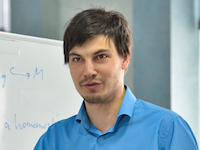|
|
Dynamics in Siberia - 2019
February 28, 2019 10:00–10:50, Novosibirsk, Sobolev Institute of Mathematics of Russian Academy of Sciences, Conference Hall
|
 |
|
 |
|
Plenary talks
|
|
|
On homology of Johnson kernel
A. A. Gaifullin |
| Number of views: |
| This page: | 193 |

 Photo Gallery Photo Gallery
|
Abstract:
Let $S_g$ be an orientable closed surface. The mapping class group $\mathrm{Mod}_g$ is the quotient of the group of orientation preserving homeomorphisms of $S_g$ onto itself by the group of homeomorphisms isotopic to the identity. The mapping class group contains a lot of interesting subgroups. The most important of them are the Torelli group $\mathcal{I}_g$ and the Johnson kernel $\mathcal{K}_g$, $\mathcal{K}_g< \mathcal{I}_g<\mathrm{Mod}_g$. Recall that the Torelli group consists of all mapping classes in $\mathrm{Mod}_g$ that act trivially on homology of $S_g$. In other words, $\mathcal{I}_g$ is the kernel of the natural surjective homomorphism $\mathrm{Mod}_g\to \mathrm{Sp}_{2g}(\mathbb{Z})$. The Johnson kernel $\mathcal{K}_g$ admits two different definitions. First, it is the kernel of the so-called Johnson homomorphism
$$
\tau\colon\mathcal{I}_g\to \frac{\bigwedge^3H_1(S_g)}
{\ker\left[
H_1(S_g)\xrightarrow{{-}\wedge\Omega}\bigwedge^3H_1(S_g)
\right]}
$$
induced by the action of $\mathcal{I}_g$ on $\pi/[[\pi,\pi],\pi]$, where $\pi=\pi_1(S_g)$. (Here $\Omega\in\bigwedge^2H_1(S_g)$ is the inverse of the intersection form.) Second, $\mathcal{K}_g$ is the subgroup of $\mathrm{Mod}_g$ generated by Dehn twists about those curves that separate $S_g$. So the group $\mathcal{K}_g$ is often called the bounding twist group. The equivalence of the above two definitions of $\mathcal{K}_g$ is a deep result due to Johnson (1985).
In 2007, Bestvina, Bux, and Margalit constructed a special cell complex called the complex of cycles on which the groups $\mathcal{I}_g$ and $\mathcal{K}_g$ act, and used it to study the homology of $\mathcal{I}_g$ and $\mathcal{K}_g$. They proved that the cohomological dimensions of the groups $\mathcal{I}_g$ and $\mathcal{K}_g$ are equal to $3g-5$ and to $2g-3$, respectively. Further, they proved that the top homology group $H_{3g-5}(\mathcal{I}_g)$ is not finitely generated. However, they did not manage to obtain the same result for the top homology group of $\mathcal{K}_g$. This will be the main result of the talk. Namely, we shall show that the group $H_{2g-3}(\mathcal{K}_g)$ contains a free abelian subgroup of infinite rank.
Language: English
|
|



 Contact us:
Contact us: Terms of Use
Terms of Use
 Registration to the website
Registration to the website Logotypes
Logotypes